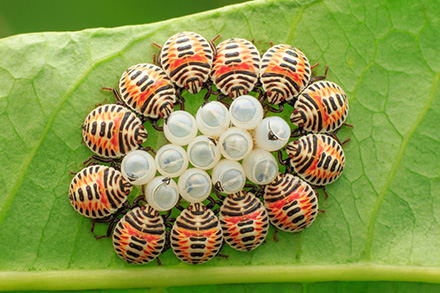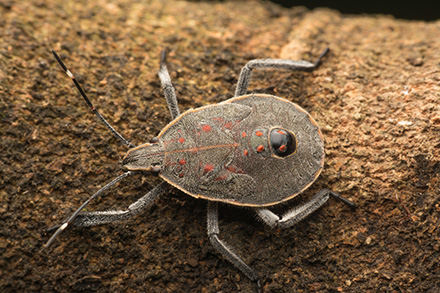PLANT PEST


Stink bugs
Exotic to Australia
Features: These stink bugs hitchhike to new areas on or in imported goods or within packing spaces and if established would eat crops and ornamental plants; become a nuisance in homes and buildings
Where they're from: Asia, North America, Europe, Oceania and South America
How they spread: Hitchhike on imported goods, including personal items, machinery and vehicles, ships, boats and aircraft
At risk: Over 300 agricultural, forestry and ornamental plant species; our way of life
While these exotic stink bugs look similar to native stink bug species, they would devastate crops and ornamental plants and become a smelly nuisance if established in Australia.
Brown marmorated stink bug is listed on both the National Priority Plant Pests and the National Priority List of Exotic Environmental Pests, Weeds and Diseases as it has the potential for significant plant industry/agriculture impacts and may also cause significant damage to our environment and social amenity.
Australian Chief Plant Protection Officer, Dr Gabrielle Vivian-Smith, provides an overview of the brown marmorated stink bug (BMSB)
Download
If you have difficulty accessing this file, please visit web accessibility for assistance.
Keep it out
These nasty bugs (Halyomorpha halys and Erthesina fullo) are hitchhikers, stowing away in all manner of imported goods and personal effects including suitcases. While they don’t pose a risk to human health, both species of stink bug can breed huge populations that become both a household nuisance and a major problem for our crop growers. They feed on more than 300 hosts including fruit trees and woody ornamentals.
If they established in Australia, they would be extremely difficult and expensive to manage, since they aren’t easily controlled with pesticides and eat a huge range of plants. They like to hide in houses in cooler weather and, as their names suggest, also emit an offensive smell.
Importing goods
To keep exotic stink bugs out of Australia, never ignore Australia’s strict biosecurity rules.
Import shipments may need to be treated and certified so before you import, check our Biosecurity Import Conditions system (BICON).
The risk of importing brown marmorated stink bugs increases from September to May. Check the current seasonal measures for incoming goods and vessels.
What to look for
Australia has its own native stink bugs which can look similar, making it tricky to spot these exotic invaders.
Key distinguishing features of the brown marmorated stink bug:
Adults:
- smaller than many stink bugs at 14–17 mm
- shield shaped
- most are marbled with a faint reddish tinge
- have white banding on the antennae
- alternate black and white markings on the edges of the abdomen
- light green to white barrel-shaped eggs laid in clusters of 25 to 30 on the underside of leaves.
Young bugs:
- are 2–12 mm long
- have a dark head with an orange to red abdomen with black stripes around the outer edges and down the centre
- do not have fully developed wings
- become darker as they grow with bands on legs and antennae.


Key distinguishing features yellow-spotted stink bug:
Adults:
- 18 mm to 23 mm long
- blackish-brown with pale yellow patches around the edge of the abdomen and a central yellow stripe from the front of the head to the scutellum (a triangular body plate in the centre of the back)
- all tibiae (lower-leg segments) have a pale band about midway
- front legs have flattened tibiae
- long head tapers towards the front
- antennae have 5 black segments and a pale-yellow band at the base of the fifth segment.
Nymphs:
- appear similar to adults but smaller and wingless
- 5 instars (stages between moulting)
- first instars have black, white and either orange or red stripes
- later instars are brownish with a yellow or orange central stripe from the head to the middle of the back, and have antennae with 4 segments.
Eggs:
- laid on leaves in clusters of 10 to 12
- barrel-shaped
- about 2.9 mm high and 1.7 mm wide
- light green when laid, becoming light brown to faint yellow before hatching.



Where to look
They can arrive in Australia on goods, vessels, mail or personal items, particularly in the warmer months. People living near ports or working with cargo will often be the first to spot them.
Check your luggage and mail
Recently travelled from East Asia, North America, South America or Europe? Check your luggage and belongings for hitchhikers.
Open luggage and mail from overseas in an enclosed space to help you contain any hitchhiking pests.
Hidden in crevices
Overseas, stink bugs hide from cold weather as winter approaches. They shelter in crevices or protected areas of goods that could be imported into Australia including:
- suitcases
- vehicles
- caravans
- machinery
- electrical equipment
- personal stored items
- shipping containers.
Feeding on crops
Stink bugs are voracious feeders that damage vegetable crops, fruit, ornamental and forestry trees. They feed on more than 300 hosts. This includes:
- apples
- beans
- citrus
- corn
- figs
- grapes
- peaches
- pears
- pine
- raspberries
- soybeans
- some ornamental plants
- tomatoes.
What to do
If you think you have found an exotic stink bug:
- take a photo
- do not disturb the bug (this may be as simple as closing the doors on a shipping container, closing your suitcase, or putting a parcel into a plastic bag)
- collect a sample of the bug, if it is possible to do so without disturbing it.
Stay informed
Importing measures during BMSB season
